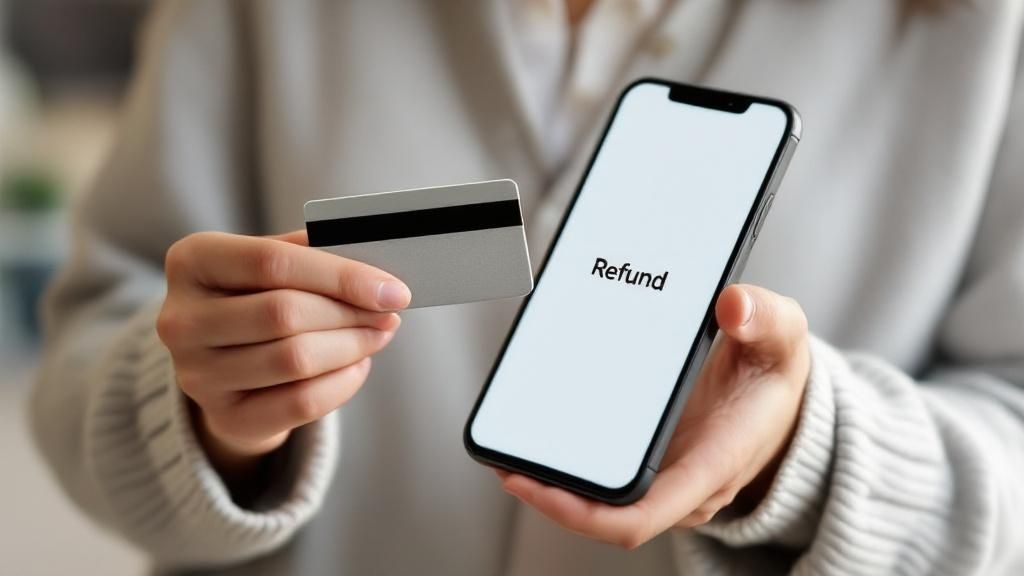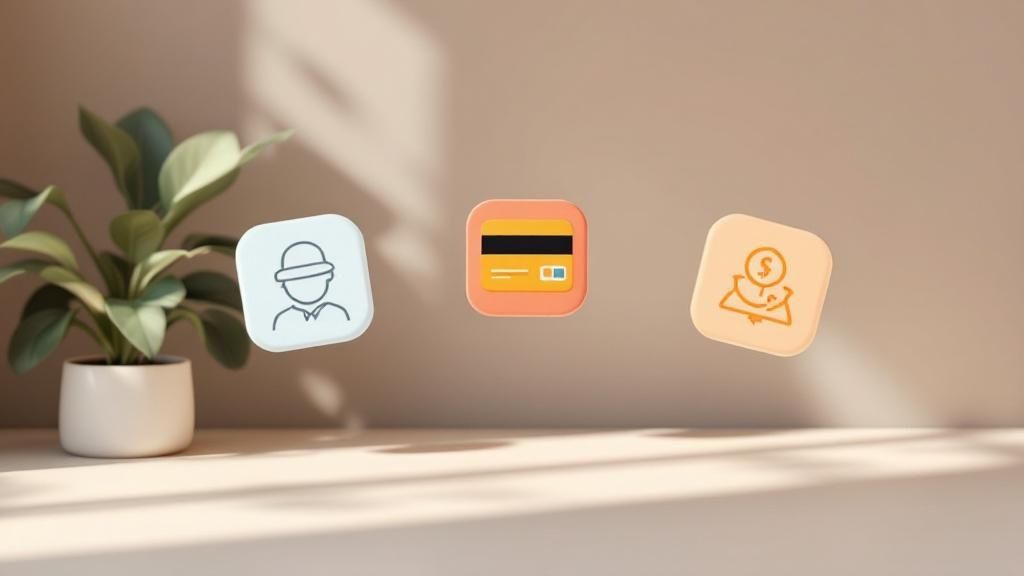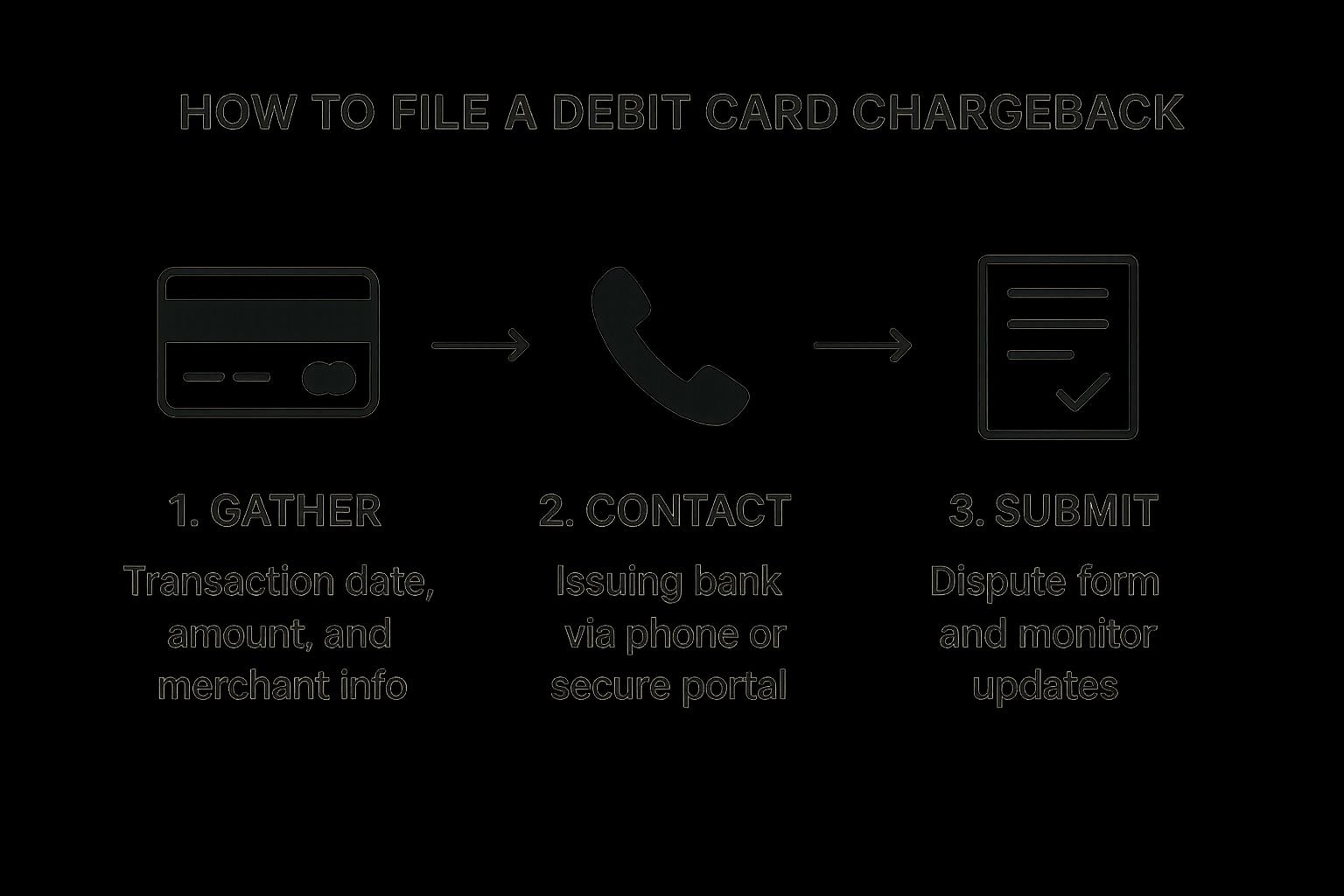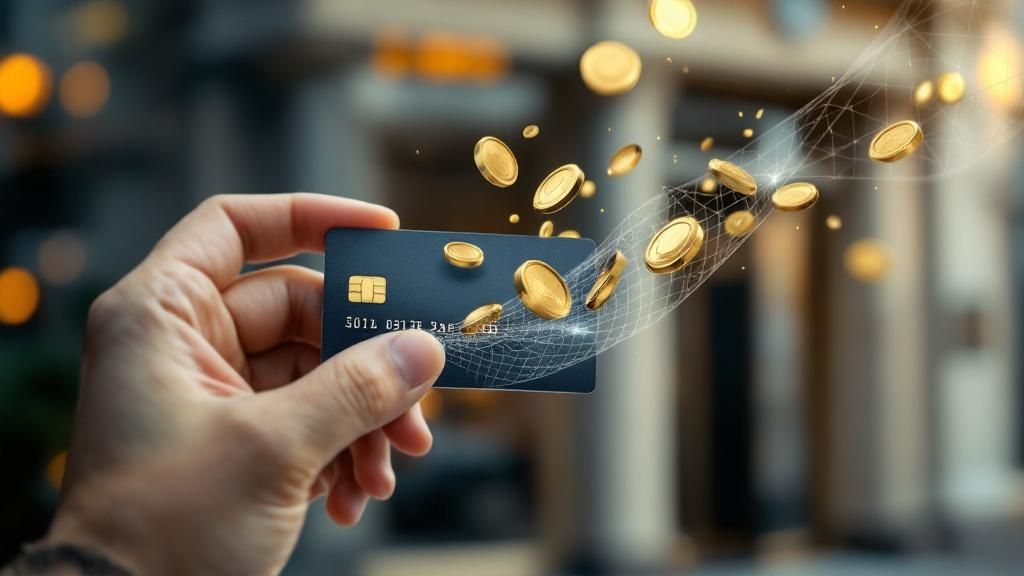
Ever spotted a weird charge on your bank statement that you know you didn't make? That's where a debit card chargeback comes in. It’s your official way of telling the bank, "Hey, this transaction isn't right," and asking them to get your money back. Think of it as a crucial safety net for the funds pulled directly from your account.
What a Debit Card Chargeback Really Means

Let's paint a picture. You order a new gadget online, the money zips out of your checking account instantly, but the package never shows up. You've tried contacting the seller, but all you're getting is radio silence. What now? This is the exact moment a debit card chargeback becomes your best friend.
This isn't just about asking for a simple refund from the store. A chargeback is a more formal—and powerful—process you start with your bank. You're essentially flagging a specific transaction as illegitimate and asking your bank to forcibly reverse it, pulling the money from the merchant's bank and putting it back where it belongs: in your account.
The Key Players Involved
There's a bit of a back-and-forth that happens behind the scenes. Knowing who's who makes the whole thing a lot less confusing.
- You (The Cardholder): The one who made the purchase and is now disputing it.
- Your Bank (The Issuing Bank): The bank that gave you your debit card. They act as your representative in the fight.
- The Merchant: The business where you spent your money.
- The Merchant's Bank (The Acquiring Bank): The bank that handles payments for that business.
When you file that dispute, your bank gets in touch with the merchant's bank to present your side of the story. The merchant then gets a chance to respond with evidence that the charge was legitimate. This exchange of proof is the heart of the chargeback investigation. You can dig deeper into how to successfully file a chargeback for a debit card in our detailed guide.
To give you a clearer picture, here's a quick breakdown of these core ideas.
Debit Card Chargeback Key Concepts
This table sums up the main ideas we've covered and what they mean for you as a cardholder.
Understanding these roles helps you see why providing clear, solid evidence is so important to winning your case.
Why Chargebacks Are Costly
While chargebacks are a fantastic tool for protecting consumers, they're a real headache for businesses and banks. The costs pile up quickly and go way beyond just the amount you're disputing.
Every single chargeback dispute costs banks roughly $9.08 to $10.32 just to process, thanks to all the administrative and investigative work involved. In the U.S., with the average disputed amount sitting around $110, you can see the financial stakes are high for everyone.
These costs are a big reason why the process is so formal and relies heavily on evidence. This consumer protection tool is meant to be a last resort, but it’s there to make sure your money is safe when a purchase goes wrong.
How Debit and Credit Card Disputes Differ

You hear about credit card chargebacks all the time, but when it comes to your debit card, you're playing a whole different ballgame. The single biggest difference comes down to one simple question: whose money is on the line?
With a credit card dispute, you're dealing with the bank's money. But when you file a chargeback on a debit card, it’s your own cash that's already been pulled from your account. This one detail changes everything.
The Laws Behind the Cards
The rules that protect you are split between two different federal acts, and knowing which one covers your transaction is critical.
- Credit Cards: The Fair Credit Billing Act (FCBA) is your main line of defense. It offers strong protections, giving you the right to dispute billing errors without it dinging your credit score while the bank investigates.
- Debit Cards: Protection for debit cards falls under the Electronic Fund Transfer Act (EFTA). This law is laser-focused on unauthorized electronic transactions—think a stolen card or a fraudulent online purchase.
While both laws are valuable, the FCBA generally gives you more power for a wider range of problems, like when you’re unhappy with the quality of goods or services. The EFTA is much more specific, zeroing in on fraud and bank errors. This means the reason for your dispute can make a huge difference in how easily you can get your money back.
Timelines and Your Financial Risk
The most practical difference you’ll feel is the immediate hit to your wallet. Since a debit card transaction takes cash straight from your bank account, that money is gone instantly. You're out the funds until the bank sorts things out, which can put a real strain on your budget.
Under the EFTA, how much you're liable for depends entirely on how fast you act. If you report a lost or stolen debit card within two business days, your maximum loss is capped at just $50. Wait any longer, and that number can shoot up to $500.
With a credit card, on the other hand, you just don't pay the disputed amount on your bill while the investigation is underway. Your day-to-day cash flow isn't affected.
This makes speed absolutely essential. Filing a chargeback on a debit card demands quick thinking and even quicker action to protect your money. With a credit card, you have more breathing room—usually 60 days after the bill arrives to file a dispute. Getting a handle on these timelines and liability rules is the key to managing your expectations and protecting the cash in your bank account.
Valid Reasons to Request a Charge-Back

Let's be clear: not every frustrating purchase is a good reason to request a chargeback on a debit card. Your bank won't just step in because you have buyer's remorse or found a better price down the street.
Chargebacks are a specific tool for situations where you, the customer, have been genuinely wronged and couldn't get it sorted out with the business directly. Knowing what counts as a valid reason is the first step. It helps you figure out if a chargeback is the right path and seriously boosts your chances of winning the case.
Fraudulent or Unauthorized Transactions
This is the most clear-cut reason for a chargeback. You're checking your bank statement and spot a purchase you know for a fact you didn't make. It’s a classic sign of fraud—someone likely got ahold of your card details and went on a shopping spree.
This bucket also covers what’s known as "friendly fraud." Sometimes this is accidental, like when a family member uses your card without asking first. No matter the reason, it's vital to report these charges immediately to secure your account. For businesses, these claims are a minefield, which is why many now use sophisticated chargeback fraud prevention strategies to protect themselves from bogus disputes.
Product or Service Not as Described
Ever ordered something online only for a completely different item to show up at your door? That’s another solid reason to file a chargeback.
Here are a few common scenarios:
- You ordered a blue sweater but received a green one.
- You paid for a brand-new laptop, but the one you got was clearly used and scuffed.
- You bought what you thought was a genuine designer handbag, but a cheap knock-off arrived instead.
The key here is a material difference. Your argument is strongest when you can prove the product’s fundamental features or condition didn't line up with what the seller advertised. Simply being a little disappointed usually isn't enough.
Billing and Subscription Errors
Mistakes happen, but you have every right to correct them when they hit your bank account. These errors often pop up as incorrect charge amounts or those pesky recurring fees for a subscription you were sure you'd canceled. Understanding concepts like the importance of expressed consent can really help make sense of why these billing disputes occur.
Some classic examples include:
- Incorrect Amount: You got charged twice for one item, or the final bill was way higher than what you agreed to.
- Canceled Subscription: You ended your gym membership weeks ago but still got charged for another month.
- Non-Delivery: You paid for a product that simply never arrived.
These issues are more common than you might think. For example, the online travel industry saw a huge 816% jump in chargebacks in early 2024, mostly tied to cancellations and service disputes. At the same time, e-commerce experienced a 222% increase, driven by shipping problems and fraud.
Your Step-by-Step Guide to Filing a Dispute
So, you've spotted a charge on your debit card that just doesn't sit right, and you're ready to do something about it. The idea of filing a chargeback on a debit card can feel a bit formal and intimidating, but it's really just a logical process. When you know the steps, you can build a strong case and handle the dispute with confidence.
Your first move—and often the simplest solution—is to reach out directly to the merchant. A quick phone call or a polite email can clear up a simple misunderstanding or billing error in minutes, getting you a refund without ever having to involve your bank. Just be sure to keep a record of these conversations: note the dates, times, and the names of anyone you speak with.
Gather Your Evidence
If a friendly chat with the merchant doesn't resolve the issue, it’s time to get your ducks in a row for the bank. Think of yourself as a detective putting together a case file. The more solid proof you have, the stronger your position will be.
Start by collecting every bit of information related to the purchase. This should include:
- Transaction Details: Pinpoint the exact date of the transaction, the amount charged, and how the merchant's name appears on your statement.
- Receipts and Invoices: Your original purchase receipt, order confirmation, or any email correspondence are your most critical pieces of evidence.
- Communications: Pull together any emails, chat transcripts, or notes from phone calls you had with the merchant. This demonstrates to the bank that you made a good-faith effort to solve the problem first.
- Visual Proof: If you're disputing a charge because an item arrived damaged or wasn't what you ordered, take clear photos or videos. Visual evidence is incredibly powerful.
Contact Your Bank to Initiate the Dispute
With your evidence compiled and organized, it's time to make it official. You can kick off the dispute process by calling the customer service number on the back of your debit card. Many banks also let you file a dispute directly through your online banking portal, which usually has a dedicated section for this.
Be ready to share all the information you've gathered. The bank representative will guide you through their process, asking for specifics about the transaction and your reason for disputing it. You’ll likely need to fill out a formal dispute form, either online or over the phone, to officially get your claim on the record.
This visual guide breaks down the core steps for getting your dispute started.

This simple, three-part process—prepare, communicate, and submit—makes the idea of filing a chargeback much less daunting.
Remember: Time is of the essence here. Under the Electronic Fund Transfer Act (EFTA), you generally have 60 days from the date your statement was sent to file a dispute, but the sooner you act, the better.
Once your dispute is filed, the bank takes over and begins its investigation. This is the part that requires patience, as your bank will communicate with the merchant’s bank, and they’ll both review the evidence. For businesses on the other end, this is where their record-keeping is put to the test. If you want to see the other side of the coin, you can learn more about how merchants avoid chargebacks with proactive strategies. In the meantime, stay in touch with your bank and keep an eye on your account for any updates or requests for more information.
So you’ve gathered your documents, filed the dispute, and hit send. Now what? The waiting game can be a bit nerve-wracking, but knowing what’s happening behind the scenes can make it a lot easier. Let’s walk through the typical process.
The first good news you’ll likely see is a provisional credit showing up in your account. Thanks to the Electronic Fund Transfer Act (EFTA), banks usually have to give you a temporary refund within 10 business days while they sort things out. This gets the money back in your hands quickly, but just remember—it isn't officially yours to keep just yet.
The Investigation Timeline
Once that temporary credit is in place, your bank officially kicks off its investigation. This isn't a quick, one-sided review. It involves a formal back-and-forth between your bank and the merchant's bank, with both sides presenting their evidence. Think of it like a mini-court case for the transaction.
While the initial credit comes fast, the full investigation takes a bit longer. Regulations give banks up to 90 days to completely resolve a debit card chargeback. During this time, the bank weighs your claim and evidence against anything the merchant sends over to prove the charge was valid. If you're curious about what that looks like from their perspective, our guide explains how to fight a chargeback and the steps they take.
Possible Outcomes of Your Dispute
After the investigation wraps up, your dispute will land on one of two outcomes. It's best to be prepared for either possibility.
1. Your Dispute Is Approved
This is the outcome you’re hoping for. The bank rules in your favor, which means the provisional credit becomes permanent. The money is yours for good, and the case is officially closed.
2. Your Dispute Is Denied
If the bank decides the merchant’s evidence is stronger, they will deny your dispute. When this happens, they’ll reverse the provisional credit, pulling those funds right back out of your account. Your bank is required to send you a written notice explaining exactly why your claim was denied.
It’s incredibly important to only file a chargeback on a debit card when you have a legitimate reason. Misusing the system, an issue often called "friendly fraud," can have serious consequences, including the possibility of your bank closing your account.
Disputes like these are becoming more and more common. As online shopping continues to grow, so do chargebacks. Global chargeback volumes are projected to hit 261 million in 2025 and are expected to climb another 24% by 2028.
Got Questions About Debit Card Chargebacks? We’ve Got Answers.
Even with a roadmap, it's totally normal for questions to pop up when you're staring down a potential debit card dispute. This stuff can feel complicated, and getting clear answers is the best way to feel confident about protecting your money. Let's dig into some of the most common things people ask.
How Long Do I Have to Dispute a Debit Card Charge?
When it comes to your money, the clock is ticking. The official rule comes from the Electronic Fund Transfer Act (EFTA), which gives you 60 days to dispute an error. This 60-day window starts from the date your bank sends you the statement showing the problematic charge. If you miss that deadline, you could lose your right to get your money back.
But here’s some real-world advice: don't wait. The moment you see a charge that looks off, jump on it. Reporting an unauthorized transaction or an error right away makes your case much stronger and gets the ball rolling with your bank much faster. Make it a habit to scan your statements as soon as they arrive.
What Happens If My Chargeback Is Denied?
Getting a denial notice is a gut punch, for sure. But it doesn't always have to be the end of the line. A denial simply means that after looking at the evidence from both you and the merchant, your bank decided the business's side of the story was more convincing. When this happens, any provisional credit they gave you will be pulled back out of your account.
Your bank is legally required to send you a letter explaining why they denied your claim. This letter is now your most important tool.
Once you know the reason for the denial, you can ask to see the evidence the merchant submitted. If you find holes in their story or have new information that wasn't included before, you may be able to appeal the decision.
Should I Contact the Merchant Before Filing a Chargeback?
Yes, a thousand times yes. In fact, most banks won't even let you start a formal dispute until you can show you've already tried to work it out with the merchant directly. Taking this first step can save you a mountain of time and frustration.
Often, a quick phone call or a polite email is all it takes to get a refund or a replacement sent out, solving the whole problem without ever needing to involve the bank. Just make sure you document every interaction. Keep a log of who you spoke to, the date and time of the conversation, and what was discussed. If you do have to file a formal dispute later, this paper trail becomes invaluable evidence.
Can I Get a Chargeback for a Service I Was Unhappy With?
This is where things get a bit gray. Chargebacks are slam dunks for clear-cut problems—think fraud, getting charged twice, or an item that never showed up. But when you're just unhappy with the quality of a service you paid for, the path isn't as clear.
Whether you'll succeed here often boils down to a few things:
- The Service Agreement: What did the contract actually promise you in writing? If you can point to specific ways the service failed to meet the written terms, your case gets a lot stronger.
- Your Bank's Rules: Each bank has its own internal policies for handling these "quality of service" disputes. Some are more lenient than others.
- Your Proof: A vague complaint like "I just didn't like it" is almost impossible to win. But if a cleaning service damaged your furniture and you have pictures to prove it? Now you've got a compelling argument.
Before you file this kind of claim, it's crucial to understand your situation and know your specific chargeback rights.
Are you an e-commerce merchant tired of losing revenue to chargebacks? ChargePay uses AI to automate the entire dispute process, helping you win back more money without lifting a finger. See how you can boost your win rates and protect your bottom line at https://www.chargepay.ai.







.svg)







.svg)
.svg)
.svg)